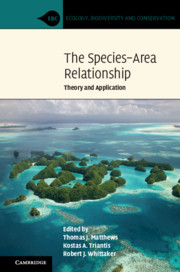Book contents
- The Species–Area Relationship
- Ecology, Biodiversity and Conservation
- The Species–Area Relationship
- Copyright page
- Contents
- Contributors
- Foreword
- Preface
- Part I Introduction and History
- 1 The Species–Area Relationship: Both General and Protean?
- 2 The History of the Species–Area Relationship
- Part II Diversity–Area Relationships: The Different Types and Underlying Factors
- Part III Theoretical Advances in Species–Area Relationship Research
- Part IV The Species–Area Relationship in Applied Ecology
- Part V Future Directions in Species–Area Relationship Research
- Index
- References
2 - The History of the Species–Area Relationship
from Part I - Introduction and History
Published online by Cambridge University Press: 11 March 2021
- The Species–Area Relationship
- Ecology, Biodiversity and Conservation
- The Species–Area Relationship
- Copyright page
- Contents
- Contributors
- Foreword
- Preface
- Part I Introduction and History
- 1 The Species–Area Relationship: Both General and Protean?
- 2 The History of the Species–Area Relationship
- Part II Diversity–Area Relationships: The Different Types and Underlying Factors
- Part III Theoretical Advances in Species–Area Relationship Research
- Part IV The Species–Area Relationship in Applied Ecology
- Part V Future Directions in Species–Area Relationship Research
- Index
- References
Summary
The discovery of the species-area relationship, or SAR, cannot be attributed to a single person or time. Rather, and as true of the description and analysis of many patterns in nature, the story started with the realization of a phenomenon which, over time, and through many individual contributions, evolved into a developed theory. The history of the SAR thus concerns both the origins and the different forms and uses of SARs. We describe how the discovery of the phenomenon eventually led to the first proposed mathematical models of the relationship in the early twentieth century. This initiated the ongoing debates on the shape of the species–area curve, the factors that underpin SARs and the most appropriate model(s) for fitting. Alongside these debates, we review the history of the uses of the SAR and the central role it has played in the development of various fields within biogeography, from island biogeography through to conservation biogeography.
Keywords
- Type
- Chapter
- Information
- The Species–Area RelationshipTheory and Application, pp. 20 - 48Publisher: Cambridge University PressPrint publication year: 2021
References
- 6
- Cited by

